Connect with us
Published
5 months agoon
By
Tyler Shultz
Researchers working in a hospital crypt in Milan, Italy have found traces of cannabis in human bones that date back to people who lived in the 1600s.
Gaia Giordano of the Department of Biomedical Science for Health at the University of Milan and her team of researchers examined nine femoral bone samples from people who lived in 1600s Milan and who were buried in a crypt at the Ca’ Granda hospital. The researchers discovered molecules of two different cannabinoids, Delta-9-tetrahydrocannabinol and cannabidiol, in the thigh bones of a young man and a middle-aged woman buried in Milan sometime between 1638 and 1697.
The team performed a toxicology analysis by powdering and preparing the bone samples so chemical compounds were able to be separated and purified, enabling the researchers to use mass spectrometry to identify the chemical components. The researchers suggest the cannabis molecules were absorbed into the bloodstream and delivered to bone tissue.
“Molecules of medicinal plants can be detected by toxicological analysis even centuries after the death of an individual,” said Gaia Giordano of the Department of Biomedical Science for Health at the University of Milan. “[t]his study reports the first physical evidence of cannabis use in Modern Age in Italy but also in Europe.”
The researchers noted cannabis “was not listed inside the pharmacopeia, suggesting that the plant was not administered as medical treatment at the time in the hospital” and Giordano suggests cannabis was used by people of all ages both recreationally and to self-medicate, most likely prepared as cakes and infusions.
“Life was especially tough in Milan in the 17th century,” said archaeotoxicologist Domenico di Candia, who led the study, to the newspaper Corriere della Sera. “Famine, disease, poverty and almost nonexistent hygiene were widespread.”
The study was published in the December issue of the Journal of Archaeological Science with the initial goal of the study being to find traces of plants used for medical or recreational purposes. The study follows a previous study conducted by Giordano that found traces of opium in cranial bones and brain tissue.
Yimin Yang at the University of Chinese Academy of Sciences in Beijing said the study was unique in the way it used the toxicology method to analyze human remains. Yang was previously involved in an excavation in the Pamir Mountain range of Central China to study the ancient tombs of the indigenous people when the team of researchers discovered ten wooden braziers at a burial site that contained evidence of highly potent burned cannabis dating back to 2,500 years ago. The cannabis residue tested confirmed the strain was more potent than any strain growing in the wild, hinting at potential early cultivation of the plant.
“Cannabis with a high THC level often contains a low level of CBD. The cannabinoids detected on the wooden braziers are mainly CBN, indicating that the burned cannabis plants expressed higher THC levels than typically found in wild plants,” said Yang. “A pattern of relatively equivalent amounts of THC and CBD would be expected for wild cannabis plants, but evident peaks corresponding to cannabinoids of CBD and its degradation products (such as cannabielsoin) were not detected in the burning residues.”
Another archaeological study found evidence of cannabis use by ancient Israelites with the researchers concluding the cannabis was burned with the intent of producing a “high” and not for medicinal purposes. Archaeologists found two limestone altars buried within a shrine in the Negev desert, south of Tel Aviv, Israel, one altar containing frankincense and the other containing traces of THC, CBD and CBN, showing cannabis may have had a role in religious worship ceremonies.


Despite City Efforts, Hemp Shops Posing as Dispensaries Prevail in Las Vegas


Cannabis Community, Investors React to DEA Decision To Reschedule


Georgia Governor Signs Bill Establishing Licensing Requirements To Grow Hemp


Study: Psilocybin Enhances Meditation


Ohio GOP Lawmakers Debate Adult-Use MJ Priorities, Eye June for Regulation Approval


Taylor Swift Puts Narcotics Into All of Her Songs on ‘The Tortured Poets Department’
